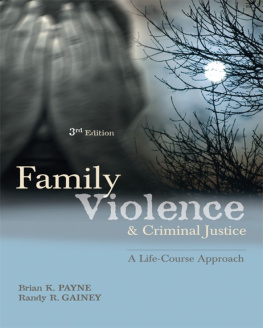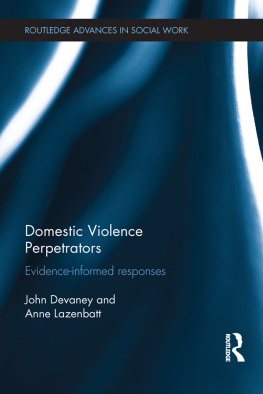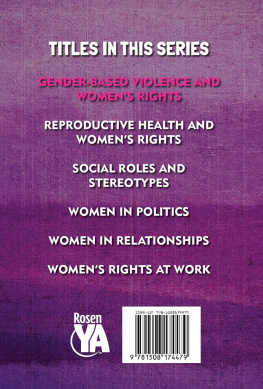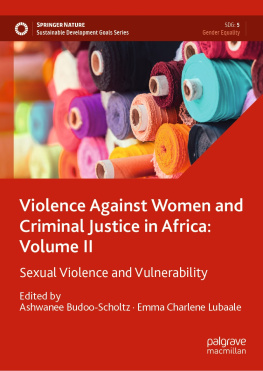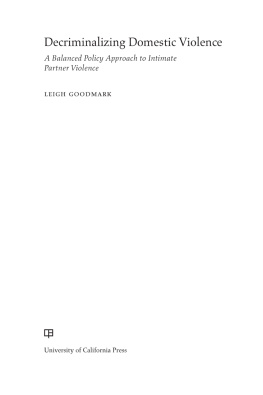Copyright
Family Violence and Criminal Justice: A Life-Course Approach, Third Edition
Copyright 2002, 2005, 2009, Matthew Bender & Company, Inc., a member of the LexisNexis Group, New Providence, NJ
ISBN-13: 978-1-42246-138-9
Phone 877-374-2919
Web Site www.lexisnexis.com/anderson/criminaljustice
All rights reserved. No part of this book may be reproduced in any form or by any electronic or mechanical means, including information storage and retrieval systems, without permission in writing from the publisher.
LexisNexis and the Knowledge Burst logo are trademarks of Reed Elsevier Properties, Inc.
Anderson Publishing is a registered trademark of Anderson Publishing, a member of the LexisNexis Group
Library of Congress Cataloging-in-Publication Data
Payne, Brian K.
Family violence and criminal justice: a life-course approach/Brian K. Payne, Randy R. Gainey 3rd ed.
p. cm.
Includes bibliographical references and index.
ISBN 978-1-42246-138-9 (softbound)
1. Family violenceUnited States. 2. Wife abuseUnited States. 3. Child abuseUnited States. 4. Older peopleAbuse ofUnited States. 5. Criminal justice, Administration ofUnited States.
I. Gainey, Randy R. II. Title.
HV6626.2.P39 2009
364.1555--dc22
Cover design by Tin Box Studio, Inc./Cincinnati, Ohio
Editor Ellen S. Boyne
Acquisitions Editor Michael C. Braswell
Dedication
To Kathleen, Chloe, Charles, and Claire BKP
To my mother, Diane, we miss you RRG
Preface
). To make room for this chapter without increasing the length of the book, we combined the former co-occurring child abuse/domestic violence chapter with the domestic violence chapter.
In the second edition, we added box inserts titled From the Field and Research Shows. We have kept the titles of those boxes but have inserted new material in the boxes to keep them up to date. In addition, because recent research shows that professionalsincluding college graduatesdo not always know enough about family violence when they enter their careers, we added another box insert titled Tool Box. The Tool Box provides specific tips for professionals dealing with issues discussed in each chapter.
Literally hundreds of studies have been published on family violence since the last edition of this book was published. We have incorporated more than 120 of those and have deleted some of the research that may be a little dated. To provide readers with the opportunity to become familiar with all of this past research, we have maintained a bibliography that lists more than 1,700 studies on family violence.
We have also added various sections throughout each chapter to make the discussion more complete. For example, in the methods chapter, we added material on quasi-experiments as they relate to family violence. In the theory chapter we added a discussion on social disorganization and the power control wheel. The child abuse chapter includes the most recent data on child maltreatment trends, and information on child fatalities has been expanded. In the domestic violence chapter, we have incorporated research on economic abuse, updated the literature related to domestic violence, and integrated the discussion on co-occurring child abuse/domestic violence. The elder abuse chapter includes an expanded discussion on elder sexual abuse, as well as the most recent data on elder abuse trends. The police, courts, and treatment chapters also include new material based on recent research on the processing of criminal justice cases. The addition of a section on restorative justice in the corrections chapter should be particularly valuable to readers.
It is comforting to see how much research is being conducted on different topics related to family violence, though it is disheartening that this research is necessary in the first place. Still, it is through this research that future professionals, researchers, college and university professors, and policymakers can develop the most appropriate response strategies to address the problem of family violence. It is our hope that Family Violence and Criminal Justice: A Life-Course Approach summarizes past research in a way that readers are better able to understand and respond to future cases of family violence.
BKP and RRG
Acknowledgments
The third edition of Family Violence and Criminal Justice is the result of the efforts of many different individuals. We are particularly indebted to Ellen Boyne at LexisNexis (Anderson Publishing) for her support in getting this edition under way and providing assistance throughout the process. We also remain appreciative of Michael Braswell for giving us the idea, and the opportunity, to write this book in the first place.
We are also indebted to Sadie Mummert for her assistance in locating and verifying references.
We would also like to thank our families for the lessons they have taught us over our life course. Payne would like to thank Kathleen, Chloe, Charles, and Claire for teaching him about the importance of family. Gainey would like to thank Edie, D. and Lar, Nicole and Lauri, and Robin and Zach for their care and support of him and their mother during the writing of the first edition of this book. I thank Brian for this edition; I owe you big!
Chapter 1. Family Violence and The Life-Course Perspective
The evening before the Grammy Awards were being held in 2009, police responded to a situation in which crooner Chris Brown was accused of assaulting a woman who was initially labeled as an anonymous victim. Eventually, word spread that the anonymous victim was, in fact, Rihannaone of the most beloved singers of her generation. While the dynamics surrounding her case may seem unique, in reality the patterns illustrate several common patterns found in domestic violence cases.
First, domestic violence is not limited to certain groups or classes. It affects everyonethe rich, the poorthe famous, the ordinaryblacks, whitesour heroes, our villains. All too often, individuals assume that violence involves only specific types of individuals. Images of the wife beater tee-shirt come to mind. Such images are misleading and result in misconceptions about family violence.
Second, Rihanna, like the thousands of victims who are victimized by domestic violence each year, knows her offender. Criminologists routinely stress that victims are more likely to be harmed by an acquaintance than by a stranger. One irony is that we fear strangers, but not the person we know. Another irony is that our crime prevention strategies target protecting us from strangers, but not people we know.
Third, if all of the reports are accurate, then Chris Brown's past is similar to the millions of offenders who have abused their partners. Hundreds of studies show that offenders have histories of violence in their childhood. Males raised in violent homes are more likely commit violence in their adult relationships. To be sure, many of those raised in these homes do not ultimately resort to violence. Still, those who live in these homegrown war zones have a higher likelihood of creating battle zones in their own lives.
Fourth, the response to family violence involves the efforts of criminal justice professionalsthe police, courts professionals, correctional employees, and so onwho are given the duty of making women like Rihanna safer. Indeed, it was the police who were initially called upon to respond to Rihanna's situation. Then, the case was processed through the rest of the justice system. In their efforts to respond to these kinds of violence, criminal justice and human services professionals will encounter victims from all stages of the life course. As will be shown throughout this text, the victim's stage in the life course will influence the causes of the violence, the consequences of the abuse, and the justice system's response.

